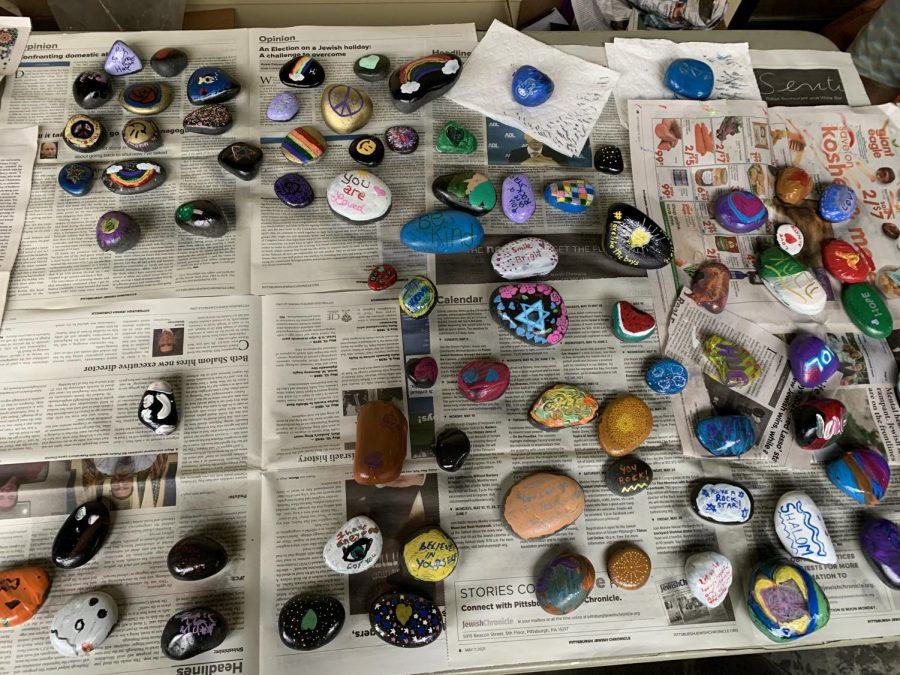Service event commemorates Tree of Life massacre, spreads positivity through art
Katie Cassidy | Contributing Writer
Hand-painted stones in the courtyard of East End Cooperative Ministries at the second annual “Service Setting Stones of Love and Hope” in Squirrel Hill on Sunday.
October 24, 2021
Despite the gloomy, overcast skies, smiles and laughter filled the courtyard of the East End Cooperative Ministries as children and adults gathered to turn stones into works of art.
Kesher Pittsburgh, in collaboration with the 10.27 Healing Partnership and Repair the World Pittsburgh, hosted “Service Setting Stones of Love and Hope,” a commemorative service event designed to bring together members of the community. People gathered to paint stones with messages of kindness and positivity that will be placed across Pittsburgh, wherever its owner sees fit.
This is the second annual “Service Setting Stones of Love and Hope” organized by Kesher to commemorate the Tree of Life massacre. The massacre took the lives of 11 Jewish worshippers during a Saturday service at the synagogue in 2018. The worshippers belonged to the three congregations — Dor Hadash, New Light and Tree of Life*Or L’Simcha — which share the Tree of Life building. It is the deadliest attack ever on the Jewish community in the United States, according to the Anti-Defamation League, a nonprofit that fights anti-Semitism.
Kesher Pittsburgh, founded by Kohenet Keshira haLev Fife, is a community dedicated to teaching and celebrating Judaism and Jewish practices. According to their website, Kesher Pittsburgh is focused on “enlivening Judaism at the intersection of spirituality and social justice.”
Fife began the event by leading a discussion on the importance of stones in Jewish tradition. Fife said the stones are often put on Jewish grave sites because they last longer than other forms of commemoration. Historically, Fife said Jacob first used the stones on graves along the road to Bethelhem, and that they continue to be used for marking grave sites.
“The smaller stones we often see used and placed today are a way to say, ‘I have been here,’” Fife said. “Hopefully the positive messages put on them today will make their way into different corners of the community.”
Fife then sent the children in attendance to learn about the meanings behind messages of hope and remembrance, while the adults began to paint their stones. Fife said an event such as this one allows them to tie in the theme of commemoration with the long-standing significance of stones in Jewish history. She said the event has a lasting impact and is well-received by the community.
“It allows people to be creative and bring their own hearts to a service project,” Fife said. “Understanding our words matter. When we write them down they can be spread far and wide and reach anyone who passes by.”
Q Rice, a fellow at Repair the World Pittsburgh, has worked with the organization since August, and said she believes events like these play a vital role in connecting communities and spreading positivity.
“It is great that we are able to come together, connect and engage with the community,” Rice said. “We are stronger together, through community we can create really special change.”
Repair the World has organized service events at 18 different sites across Pittsburgh during the month of October. The service events, open to all members of the community, fall into one of four categories — caring for the community, health and wellness, civic engagement and tending the earth. According to their website, Repair the World “mobilizes Jews and their communities to take action to pursue a just world.”
Madelyn Dinnerstein, a community member from Ross Township, took part in the stone decorating event because she has seen the positive impact of service projects. Dinnerstein said she is not affiliated with either Repair the World or Kesher, but saw an advertisement and knew it would be a good opportunity.
“I have seen rock placements done before, and I really liked the idea of it,” Dinnerstein said. “Sometimes if somebody is having a bad day and they find something like this, it can cheer them up.”
Becca Hurowitz, a Repair the World advisory board and Kesher program member, said these events bring together generations for a common good. Hurowitz said she brought her son to the event because she wants him to feel like he is part of a larger community and has the ability to make an impact.
“This is all about thoughtfulness and bringing up different conversations,” Hurowitz said. “It is about learning and reflection, and it’s customized enough for everyone to get something out of it.”
Hurowitz said while it is important to be sensitive when discussing the Tree Life massacre with children, she makes an effort to keep the discussions open and honest with her own children.
“As much as I would love to shield them, they know this kind of thing happens,” Hurowitz said. “Tying service to commemorating lives that were lost is particularly meaningful. I want my kids to know they have the potential to lift spirits and that a little effort goes a long way.”








